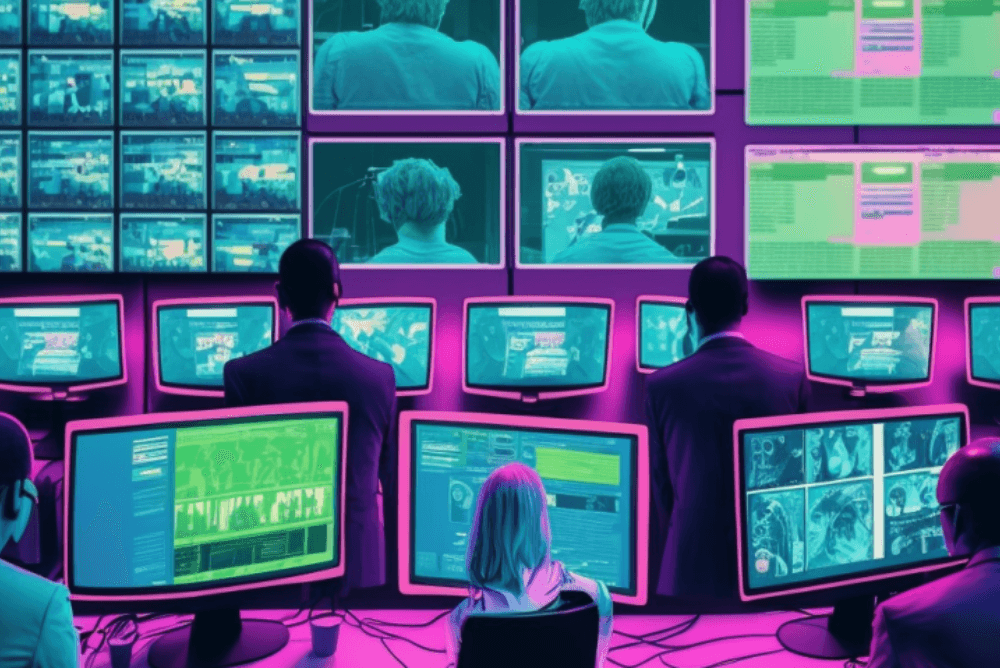Expert’s voice: The power of UX ethnographic research in a newsroom
17 Mar 2023
Ethnographic research in a newsroom – photo generated by Midjourney
Interview with Elwira Majewska and Grzegorz Wiktorski, UX Designers at Autentika
"What people say what people do and what people say they do are entirely different things," said world-renowned anthropologist Margaret Mead, long before the concept of user experience was introduced to a broader audience in the 1990s. Her words are surprisingly actual regarding user research – and the reason why UX teams use ethnographic research to gain insights into user experiences. Learn how we go about it at Autentika.
At Autentika, we help media transform and grow by improving the UX and efficiency of their editorial software. UX research – including ethnographic research – is a crucial part of our work process, as it allows us to understand how users interact with their back-office systems.
We asked Autentika's UX design experts – Elwira Majewska and Grzegorz Wiktorski – how they conduct ethnographic research in a newsroom and what insights they gained during Autentika's cooperation with several top media companies. Here’s what they said.
Listen to the audio version of this article or read the transcript that follows below the player
Joanna Kocik: Let’s start with some basics. Could you tell us what ethnographic research is and how it differs from other research methods in UX design?
Elwira Majewska: Ethnographic research is a method that focuses on observing the behaviour of users in their natural environment – such as the workplace or community. In our case, it’s the newsroom. We observe and document people's activities and interactions rather than run surveys and interviews (which we do in other stages of the UX research).
Ethnographic research can be based on pure observation or combined with contextual interviewing. In our case, we sit behind journalists, observe them doing their job, and ask questions in crucial moments.
Grzegorz Wiktorski: One of the key differences between ethnographic research and other qualitative research methods is the amount of required time and effort. Ethnographic research involves longer and more immersive observation and data collection periods, often spanning days or even weeks. This allows researchers to gain a more nuanced and comprehensive understanding of users' behaviour and context. Still, it also requires a more significant investment of time and resources than other research methods.
Ethnography costs time – however, the big positive outcome is a massive amount of insights and data that neither IDI (in-depth interviews) nor any other method can provide.
We’ll get back to quantitative vs qualitative methods later – now, let’s talk about the benefits of ethnography. Margaret Mead, the world-renowned anthropologist, famously said: "What people say, what people do, and what people say they do are entirely different things”. Is that true regarding ethnographic research? Is it a process that can help teams better understand their users?
Grzegorz: This is one of the fundamental principles in UX design – don't listen to users; observe them. Of course, we shouldn't be so strict with this rule. Still, validating the participants' statements by their actions is essential because they aren't always aware of their behaviour or might give biased answers during the interview.
Don't get me wrong – I don't mean that users are lying or have bad intentions, but it's common to forget something or ignore little things that could be a real deal.
Finally, ethnographic research allows us to gain a deeper contextual understanding of users. By observing them directly, we can uncover the nuances of their behaviour, needs, and pain points that we may not be able to capture with other research methods. By immersing ourselves in the user's environment, we can see the big picture and understand the broader context in which they operate.
Elwira: One example is the pop-up window that appears every time you paste the text. Under normal circumstances, this would not be a problem. However, when it appears dozens of times a day, it is annoying and delays your work.
Ethnography also makes us discover unmet needs. It means that people see something as “normal” when it’s far from ordinary. A good example is the software's lack of 'help'. During one of our research sessions, it became clear that users do not know what certain functions are used for and have no way to find out. And they accepted this state though it was far from being a model situation.
Can you describe some key insights from your ethnographic research in newsrooms and how you apply them in your design work?
Grzegorz: In some of the interviews, journalists indicated that they follow strict SEO rules considering the headlines and titles the SEO team gives them via the daily bulletin. During the ethnographic research, we found none of the participants looked at the document. The reason was that most of them thought that every SEO bulletin contained the same information, so it was not worth opening and rereading it.
In this case, it would be better to incorporate the bulletin’s guidelines into a simple, streamlined text-check process during writing.
Elwira: We observed an interesting moment when a newly hired editor finished her shift. She was supposed to hand over her duties to the next editor, but she only knew his first name. There were several people in this newsroom with the same name, and she did not know which person was the right one. In this case, it would have been helpful if the software had included a list of the people working in the newsroom that day, their schedules and their tasks.
Another surprising observation was how much time editorial teams spend communicating and sharing messages on different channels. Much of this work could be automated by adding functionality to the software and integrating the CMS with the communicators. This could speed up their work.
Read also: Can digital media be faster than Twitter? How to cut time to publish by 70%

Ethnographic research allows for many interesting observations (image generated by Midjourney)
What were some of the challenges you faced during this process?
Grzegorz: The most common problem is access to research participants. Our research involves observing and interacting with people in their workplaces. They are busy – but they also might have some privacy concerns.
Second, it's difficult to maintain the user's attention and full focus during research – it's not easy to stay 100% engaged for several hours, and we're very aware of that. Therefore, we usually mix the two approaches: shadowing and contextual interviewing, in one session. This gives us a perfect pace and balance.
Another approach is the "think-aloud protocol." At the beginning of each session, we encourage participants to speak out about whatever they're thinking or processing. However, this can be uncomfortable or unnatural behaviour for participants, and they may forget about it despite reminders.
To counteract this, we often ask contextual questions during the session, such as 'What happened?' or 'Can you tell me more about this?' This helps remind participants of the think-aloud protocol and allows deeper insights into their experiences and thought processes.
Elwira: It's no secret that journalists see us doing research. Hence the big challenge is to minimise the influence of the observer (that is, of us) on the process. We try to be quiet during the observation and interrupt the participant only at important moments.
How do people usually react to your presence? Do they feel comfortable sharing their experiences and perspectives?
Elwira: We know that our presence in a newsroom can be somewhat stressful, but we approach people with an open mind and a positive attitude. We are ordinary, friendly people who smile and talk to them.
I must also add that ethnography is not "entry-level" research either. It's not like we come in off the street and start working in the newsroom. We are first introduced to the team, and our presence is anticipated.
Grzegorz: During the observation sessions, we found that people can react differently depending on the context and their comfort level with being observed. For example, in a newsroom, some participants may feel insecure or stressed when observed, which can affect their behaviour, reactions and work efficiency. We always try to create a comfortable environment and make sure we are the good guys. Despite our best efforts, some participants may be reluctant to share their experiences and perspectives. In these situations, we try to adjust our approach by asking open-ended questions and using active listening techniques to encourage participants to share more.
We also try to be flexible and responsive to participants' needs, whether that means taking breaks, adjusting the timing or duration of the session, or changing our methods to meet their needs better.
Let’s return to the differences between qualitative and quantitative research. How do you combine the qualitative insights gained from your ethnographic research with other data types?
Grzegorz: Let's be honest – first the numbers, then the questions. Quantitative data comes first because it allows us to identify general findings, behaviours, and patterns that we can further explore through ethnographic research.
Quantitative data, for example, can help us identify areas of drastic productivity loss within the software that we can target in our ethnographic research.
When we then combine the qualitative findings from the ethnographic research with the quantitative data, we get a complete understanding of user behaviour and issues. We can make design decisions based on solid evidence.
Read also: 13 numbers behind the improved publishing workflow

Image generated by Midjourney
Do you usually work in a team of two? Why?
Elwira: We do not work alone. We see different things and can exchange observations. After each session, we compare the results of the observations. Most of the time, we say, "Wow, I did not see that, great".
We also brainstorm after research to draw conclusions. On our own, it would be difficult to do.
Plus, we like to work together!
Maybe it’s a tricky question, but can you do ethnographic research in a remote or hybrid work environment?
Grzegorz: Doing research remotely or in a hybrid work environment is certainly possible. There are various methods, such as netnography, which uses digital methods to study online communities and social networks, or remote user sessions, similar to traditional user testing conducted using video conferencing software or other remote tools.
It should be noted, however, that these approaches cannot fully replicate the experience of traditional ethnographic research, which requires deep immersion in the natural context of participants, which can be challenging to achieve remotely. We may be unable to observe nonverbal cues or miss critical social factors that can influence participant behaviour.
Elwira: There are no standard practices for remote ethnography in UX. We try to be up to date-with these methods. However, we believe they cannot replace offline ethnography and contact with users at this stage.
And maybe this is good, as it makes us all meet in person and not remotely on Zoom or Google Meets! Thank you so much for your time and those exhaustive answers.
If you – as a media professional – have any additional questions or want to chat about digital transformation in your newsroom – reach out!
Watch: Let’s cut through the noise: Which AI tools in journalism are really worth the hype?



